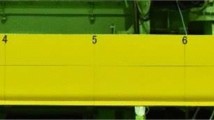Abstract
In this paper we propose a two-buoy wave energy converter composed of a heaving semi-submerged cylindrical buoy, a fixed submerged cylindrical buoy and a power take-off (PTO) system, and investigate the effect of the fixed submerged buoy on the hydrodynamics of the heaving semi-submerged buoy based on the three-dimensional potential theory. And the dynamic response of the semi-submerged buoy and the wave energy conversion efficiency of the converter are analyzed. The difference of the hydrodynamics and the wave energy conversion efficiency of a semi-submerged buoy converter with and without a fixed submerged buoy is discussed. It is revealed that the influence of the fixed submerged buoy on the exciting wave force, the added mass, the radiation damping coefficient and the wave energy conversion efficiency can be significant with a considerable variation, depending on the vertical distance between the heaving semi-submerged buoy and the fixed submerged buoy, the diameter ratio of the fixed submerged buoy to the heaving semi-submerged buoy and the water depth.
Similar content being viewed by others
References
Falcao A. F. de O. Wave energy utilization: A review of the technologies [J]. Renewable and Sustainable Energy Reviews, 2010, 14(3): 899–918.
Vantorre M., Banasiak R., Verhoeven R. Modelling of hydraulic performance and wave energy extraction by a point absorber in heave [J]. Applied Ocean Research, 2004, 26(1): 61–72.
Agamloh E. B., Wallace A. K., Jouanne A. V. Application of fluid–structure interaction simulation of an ocean wave energy extraction device [J]. Renewable Energy, 2008, 33(4): 748–757.
Yang C., Zhang Y. L. Experimental study on operation performance of wave-driven pressure pump [J]. Journal of Hydraulic Engineering, 2013, 44(9): 1107–1111(in Chinese).
Yang C., Zhang Y. L. Experimental study on operation performance of wave pressure pump [C]. Proceedings of 1st International Conference on Renewable Energies Offshore, Lisbon, Portugal, 2014.
Zheng S., Zhang Y. Wave radiation from a truncated cylinder in front of a vertical wall [J]. Ocean Engineering, 2016, 111: 602–614.
Zheng S., Zhang Y. Wave diffraction from a truncated cylinder in front of a vertical wall [J]. Ocean Engineering, 2015, 104: 329–343.
Chen X. B., Zhan J. M., CHEN Q. Numerical simulations of 2-D floating body driven by regular waves [J]. Journal of Hydrodymics, 2016, 28(5): 821–931.
Bhatta D. D., Rahman M. On scattering and radiation problem for a cylinder in water of finite depth [J]. International Journal of Engineering Science, 2003, 41(9): 931–967.
Wu B. J., Zeng Y. H., YOU Y. G. et al. On diffraction and radiation problem for a cylinder over a caisson in water of finite depth [J]. International Journal of Engineering Science, 2004, 42(11-12): 1193–1213.
Hassan G., Bora S. N. Exciting forces for a pair of coaxial hollow cylinder and bottom-mounted cylinder in water of finite depth [J]. Ocean Engineering, 2012, 50: 38–43.
Su Y. L., You Y. G., Zheng Y. H. Investigation on the oscillating buoy wave power device [J]. China Ocean Engineering, 2002, 16(1): 141–149.
Falcao A. F. de O. Modelling and control of oscillatingbody wave energy converters with hydraulic power takeoff and gas accumulator [J]. Ocean Engineering, 2007, 34(14-15): 2021–2032.
Zheng Y. H., Shen Y. M., You Y. G. et al. Hydrodynamic properties of two vertical truncated cylinders in waves [J]. Ocean Engineering, 2005, 32(3): 241–271.
Wu B. J., Zheng Y. H., YOU Y. G. et al. On diffraction and radiation problem for two cylinders in water of finite depth [J]. Ocean Engineering, 2006, 33(5): 679–704.
Wu B. J., Hu C., Zheng Y. H. et al. Heaving-motion response of two freely floating vertical cylinders [J]. Journal of Hydrodynamics, Ser. A, 2006, 21(4): 458–464(in Chinese)
Candido J., Justino P. A. P. Modelling, control and Pontryagin Maximum Principle for a two-body wave energy device [J]. Renewable Energy, 2011, 36(5): 1545–1557.
Wu B. J., Wang X., Diao X. H. et al. Response and conversion efficiency of a wave energy device consisting of double cylindrical semi-submerged buoys with two degrees of freedom [J]. Scientia Sinica Physica, Mechanica and Astronomica, 2013, 43(8): 978–986(in Chinese)
Lin L. Q., Wu C. X., Wu B. J. Study on power conversion features of the two-buoy wave energy device [J]. Journal of Shanghai Ocean University, 2014, 23(3): 475–480(in Chinese).
Acknowledgement
This work was supported by the State Key Laboratory of Hydro-Science and Engineering, Tsinghua University (Grant No. 2013-KY-4).
Author information
Authors and Affiliations
Corresponding author
Additional information
Project supported by the National Natural Science Foundation of China (Grant Nos. 51079072, 51279088), the National High Technology Research and Development Program of China (863 Program, Grant No. 2012AA052602).
Biography: Cen Yang (1986-), Female, Ph. D. Candidate
Rights and permissions
About this article
Cite this article
Yang, C., Zhang, Yl. Numerical study of hydrodynamic behavior and conversion efficiency of a two-buoy wave energy converter. J Hydrodyn 30, 235–248 (2018). https://doi.org/10.1007/s42241-018-0025-6
Received:
Accepted:
Published:
Issue Date:
DOI: https://doi.org/10.1007/s42241-018-0025-6




